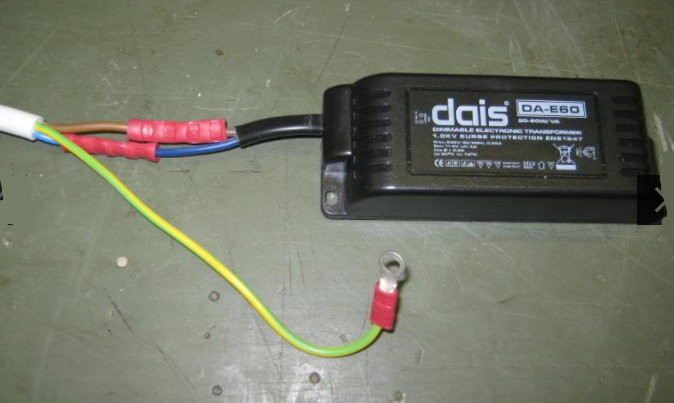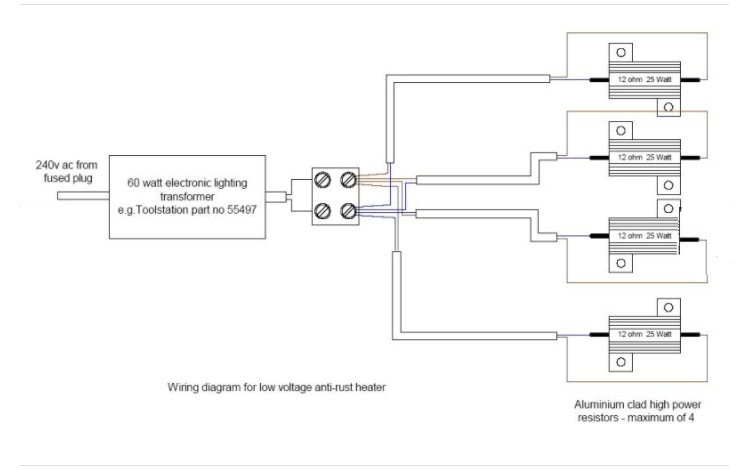9fingers
Established Member
Apologies to Keats but it just seemed appropriate :lol:
Some years ago I made reference to the anti rust heaters that I had fitted to my table saw.
viewtopic.php?t=14547
The principle is that if an iron surface is kept slightly warmer than the surrounding air, then moisture will not condense onto the surface and rust will not form. Clearly of the roof leaks this method will not work but provided the building is in good condition then applying a modest amount of heat directly to the machine will keep it rust free.
I have been using this on machines for years. My engineering lathe is 32 years old and has not one speck of rust on it.
Every now and then I get a query on this system so as I have been building a new one, I thought I would write it up.
It is important that the heaters are low voltage and isolated from the mains. 12 volts is ideal and in the last few years some very cheap lighting transformers have come on the market. The designs are strictly regulated and have to work continuously whilst being efficient which means they run cool and are fully protected against short circuits.
Currently a 60 watt transformer costs £3.28 inc vat here http://www.toolstation.com/shop/Lightin ... 638/p55497
60watts is more than enough to protect a large table saw, bandsaw etc.
Cast iron is a relatively poor conductor of heat so it is more effective to fit a number of heat sources distributed across the underside of the table.
The heater elements are wirewound resistors encased in aluminium and with two fixing screws.
http://uk.rs-online.com/web/p/high-power/0160720/
The power in a resistor is given by the voltage squared divided by the resistance.
So from a 12 volt supply , a 12 ohm resistor will dissipate 12 watts and four of these will be adequate for most applications and draw 48 watts (4 x 12) from the 60 watt transformer so well within its capabilities.
First job is to extend the mains lead on the transformer using a couple for crimped connectors and providing an earth tag to make sure the machine is earthed ( this is because it cannot be guaranteed that the machine is plugged in and earthed - better safe than sorry!)

a length of heatshrink sleeving add further insulation and keeps everything tidy

The transformer has a pair of short output leads and to make it easier to connect four heaters, I added a terminal block - sometimes called choc block.

The resistors are soldered to cables and more heatshrink sleeving to insulate the connection for belt and braces.

It make no difference which way round the heaters are connected but to keep it tidy looking I kept all the brown leads together.

Drawing it out as a schematic diagram

Another advantage of using a lighting transformer as above is that the power can be reduced using a dimmer switch such as
http://www.toolstation.com/shop/Electri ... 633/p18884
The way to set the dimmer is to feel the machine table on a cold day. The table does not need to be warm to the touch but just not as cold as another unheated metallic surface. once the dimmer setting has been found - mark the position of the knob for future use. It is not essential to have a dimmer control but it can reduce the electricity consumed.
I hope this might help you have a rust free winter.
Bob
Some years ago I made reference to the anti rust heaters that I had fitted to my table saw.
viewtopic.php?t=14547
The principle is that if an iron surface is kept slightly warmer than the surrounding air, then moisture will not condense onto the surface and rust will not form. Clearly of the roof leaks this method will not work but provided the building is in good condition then applying a modest amount of heat directly to the machine will keep it rust free.
I have been using this on machines for years. My engineering lathe is 32 years old and has not one speck of rust on it.
Every now and then I get a query on this system so as I have been building a new one, I thought I would write it up.
It is important that the heaters are low voltage and isolated from the mains. 12 volts is ideal and in the last few years some very cheap lighting transformers have come on the market. The designs are strictly regulated and have to work continuously whilst being efficient which means they run cool and are fully protected against short circuits.
Currently a 60 watt transformer costs £3.28 inc vat here http://www.toolstation.com/shop/Lightin ... 638/p55497
60watts is more than enough to protect a large table saw, bandsaw etc.
Cast iron is a relatively poor conductor of heat so it is more effective to fit a number of heat sources distributed across the underside of the table.
The heater elements are wirewound resistors encased in aluminium and with two fixing screws.
http://uk.rs-online.com/web/p/high-power/0160720/
The power in a resistor is given by the voltage squared divided by the resistance.
So from a 12 volt supply , a 12 ohm resistor will dissipate 12 watts and four of these will be adequate for most applications and draw 48 watts (4 x 12) from the 60 watt transformer so well within its capabilities.
First job is to extend the mains lead on the transformer using a couple for crimped connectors and providing an earth tag to make sure the machine is earthed ( this is because it cannot be guaranteed that the machine is plugged in and earthed - better safe than sorry!)
Code:
[img]http://i115.photobucket.com/albums/n313/9fingersphotos/IMG_1727.jpg[/img]
a length of heatshrink sleeving add further insulation and keeps everything tidy
Code:
[img]http://i115.photobucket.com/albums/n313/9fingersphotos/IMG_1729.jpg[/img]
The transformer has a pair of short output leads and to make it easier to connect four heaters, I added a terminal block - sometimes called choc block.
Code:
[img]http://i115.photobucket.com/albums/n313/9fingersphotos/IMG_1730.jpg[/img]
The resistors are soldered to cables and more heatshrink sleeving to insulate the connection for belt and braces.
Code:
[img]http://i115.photobucket.com/albums/n313/9fingersphotos/IMG_1738.jpg[/img]
It make no difference which way round the heaters are connected but to keep it tidy looking I kept all the brown leads together.
Code:
[img]http://i115.photobucket.com/albums/n313/9fingersphotos/IMG_1741.jpg[/img]
Drawing it out as a schematic diagram
Code:
[img]http://i115.photobucket.com/albums/n313/9fingersphotos/Heaterwiring.jpg[/img]
Another advantage of using a lighting transformer as above is that the power can be reduced using a dimmer switch such as
http://www.toolstation.com/shop/Electri ... 633/p18884
The way to set the dimmer is to feel the machine table on a cold day. The table does not need to be warm to the touch but just not as cold as another unheated metallic surface. once the dimmer setting has been found - mark the position of the knob for future use. It is not essential to have a dimmer control but it can reduce the electricity consumed.
I hope this might help you have a rust free winter.
Bob






































